Tomasz Karski1*, Jacek Karski2, Klaudia Karska3, Paul Ochen4
1Professor, Vincent Pol University of Lublin, Poland
2Paediatric Orthopaedic and Rehabilitation Department of Medical University of Lublin, Poland
3Department of Paediatric Radiology of Medical University of Lublin, Poland
4Ogojoi Rehabilitation Care Center, Soroti, Uganda
*Correspondence author: Tomasz Karski, Professor, Vincent Pol University of Lublin, Poland; Email: [email protected]
Published Date: 27-06-2023
Copyright© 2023 by Karski T, et al. All rights reserved. This is an open access article distributed under the terms of the Creative Commons Attribution License, which permits unrestricted use, distribution, and reproduction in any medium, provided the original author and source are credited.
Abstract
In the pathology of children, from the orthopedic point of view, there commonly occur problems connected with the Syndrome of Contractures and Deformities described by Professor Hans Mau from Germany. His observations have been made between 1960 and 1980, additionally, in this subject, there are observations from Lublin (Tomasz Karski and Jacek Karski) from 1995-2023.
The second group of causes of pathologies in children which if not properly treated, can also occur in adults leading to problems of locomotor system disorders connected with abnormalities of the Central Nervous System – Minimal Brain Dysfunction (MBD). This article is devoted to the MBD problems.
Keywords: Minimal Brain Dysfunction; The Anterior Tilt of The Pelvis; Hyperlordosis of The Lumbar Spine; Hyperextension of The Knees; Valgus of The Feet
Introduction
Some children’s “muscular-skeletal system” disorders can be seen early in newborns and babies. They are symptoms of Minimal Brain Dysfunction (MBD). These abnormalities are caused by an asphyxia of the fetus during pregnancy or delivery. If these disorders are not cured in the first early months and years of the child’s life – they can influence the development of movement apparatus in adults. Clinically, symptoms of Minimal Brain Dysfunction (MBD) are, limited abduction of the hips in newborns and babies and later in older children, we observe valgus deformity of the feet, hyperextension of the knees, the anterior tilt of the pelvis, hyperlordosis of the lumbar spine and also the psychological disorders as seen in Attention Deficit Hyperactivity Disorders (ADHD). Children with MBD are inclined to hyperactivity, for example, jumping too frequently, which can lead to Perthes disease [1-14].
MBD: causes, epidemiology. According to doctors of obstetrics and gynecology (Prof. Jan Oleszczuk from Lublin and others), the causes of MBD in children are associated with pathologies in the gravidity period or delivery: (1) chronic inefficiency of the placenta, (2) intrauterine limitations of the fetus growth, (3) oligohydramnios, (4) spotting, (5) uterus contractions during pregnancy, (6) excessively intense action of the uterus during delivery as well as uterine tetanus, (7) hypertension, (8) hypotension, (9) anemia, (10) stress and noise, (11) infection of the urinary tract, (12) Twin – Twin Transfusion Syndrome, (13) difficult delivery, (14) often leading to the use of forceps during delivery, (15) overdoses or improper medication during delivery, (16) mellitus at newborns observed by bigger than normal babies [12-29]. The tonus of the muscles in MBD mostly is higher, but joints show laxity.
In this article we explain that “the laxity of joints” is not caused by “low tension of the muscles”, but by “changed properties of collagen”.
Presentation of disorders connected with MBD:
Feet (Fig. 1)
Valgus or Plano -valgus deformity of the feet. Very often, children with MBD have the spasticity or sub-spasticity of flexors of feet and with time, it leads to the shortening of m. triceps surae and Achilles tendon. As a result, valgus or Plano – valgus deformity of feet develops. To walk, we need dorsal flexion of the feet. Because of the shortening of the Achilles tendon, it is possible only in “the prone position of feet”. With time, the valgus deformity of the feet develops. The first to describe this “connection” was Prof. Jean Meary from Paris, France in the years 1960 – 1970 [1-9,24].
Hip Dysplasia (Fig. 2)
Hip dysplasia appears in three pathological conditions:
- In Syndrome of Contractures and Deformities (SofCD) – H. Mau, T. Karski and J. Karski – 90 % of all cases in Poland
- In the situation of general laxity of the joints – ca. 5 % of all dysplasia cases in Poland. Laxity is connected with MBD
- In children with MBD – because of spasticity or sub-spasticity of the adductor muscle of the hips-ca. 5 % of all dysplasia cases in Poland
Independently from pathological causes, in all cases of dysplasia, the important pathological symptom is the limited abduction of the hip or hips [13-18,25,26,29,30].
Straight Position of The Trunk (Fig. 3)
As mentioned above, the laxity of joints and spasticity or sub-spasticity of muscles are parallel. The spasticity of the extensor muscles of the trunk is very frequent. Because of this – the spine in children with MBD symptoms is in a straight position. The “extension position of the trunk” makes the development of scoliosis easy. Our next piece of information – we should never tell children to “sit straight”. Children and adults should always sit in a relaxed position [10,11,21].
Recurvatum and Valgus Deformity of The Knees (Fig. 4)
Recurvatum of the knees is very often accompanied by symptoms of a valgus deformity of the feet. This deformity of the knees is also the effect of a shortening of the Achilles tendon and m. triceps surae. Recurvation of the knees is the compensatory deformity.
Explanation: a/ It exist limitation of the dorsal flexion of the feet because of a shortened m. triceps surae and Achilles tendon, b/ During walking, at the moment when the foot is in full contact with the floor – stance Phase, hyperextension of the knees must appear as a compensatory deformity [1-14,29].
Anterior Tilt of The Pelvis and Hyperlordosis of The Lumbar Spine (Fig. 5)
In children with Minimal Brain Dysfunction (MBD) independently of valgus deformity of the feet and recurvation of the knees, we very often observe an anterior tilt of the pelvis with hyperlordosis of the lumbar spine. This pathology is caused by the shortening, which is a contracture, of flexors of the hips – mostly shortening of m. rectus. This anterior tilt of the pelvis and hyperlordosis of the lumbar spine has a big influence on the development of the so-called idiopathic scoliosis [10-18,21,22,30].
Laxity of Joints (Fig. 6)
In children with MBD, we observe the spasticity or sub-spasticity of muscles – mostly flexors of hips, knees, feet, and extensors of the trunk and at the same time laxity of joints. The laxity of joints is the result of changes in the properties of collagen. Every situation of “asphyxia” of the fetus during pregnancy or delivery leads to symptoms of MBD – of which one is “laxity of joints” [10-22,30].
Psychological problems in children with MBD – and their influence on “status of health”. In children with Minimal Brain Dysfunctions, there are not only “orthopedic disorders” but also changes in psychological behavior.
- The psychological behavior of children with MBD is different. Children affected by the changes of MBD are very often nervous, shout, and cry without any reason, and at the same time, they look for close contact with the mother, father, or grandparents very willingly – attention-seeking behaviors. They look for and need the love of their parents and the whole family.
- These children are not only active verbally but also very active physically. They like to jump off various high objects such as stairs, chairs, sofas, window stills, tree branches, and other objects within their environment. Repeated jumping many times, for example, 20 – 30 per day can cause Legg – Waldenström – Calve – Perthes disease which leads to necrosis of the femoral head. Repeated jumping for many days, weeks, or months can result in fractures of the spongy parts of the femoral head – and this is “the start of the process of the femoral head necrosis” what we simply call, “Perthes disease [23-29].
Physiotherapy in the treatment and prophylaxis of MBD disorders.
In the treatment of deformed feet, the knees, and the position of the pelvis as well as movement of the hips – the first role is stretching exercises to obtain symmetry of the anatomy, symmetry of the parts of the body, the proper length of tendons, fascias, muscles, capsules and also the symmetry of movement of the joints as well as the symmetrical function in every form of activity.
Hips: Very important is the proper nursing of the child – with only flexion and abduction of the hips during the first 12 months of life or longer. Sometimes it is necessary to use the “orthopedic abduction devices”. It is important in the program for the prevention of hip dysplasia (Fig. 7).
The anterior tilt of the pelvis and hyperlordosis of the lumbar spine – in the therapy, stretching exercises of flexors of the hips. When this therapy is done repeatedly over a long time, or for many years, will give good results (Fig. 8).
Knee: Hyperextension (recurvation) deformity – is a compensatory pathology if the m. triceps surae and Achilles’s tendons are too short. The therapy is in the form of stretching both these “anatomical units” (Fig. 9).
Feet Deformity: Important are stretching exercises for lengthening of m. triceps surae and Achilles tendon like in knee recurvation (Fig. 9).
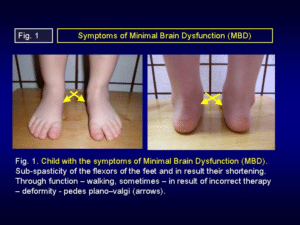
Figure 1: Child with the symptoms of Minimal Brain Dysfunction (MBD). Sub-spasticity of the flexors of the feet and as a result their shortening. Through functions like walking early and sometimes as a result of incorrect therapy we notice a deformity like pedes Plano-valgus (arrows).
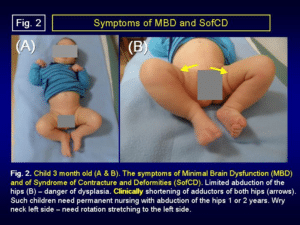
Figure 2: Child 3-month-old (A and B). The symptoms of Minimal Brain Dysfunction (MBD) and Syndrome of Contracture and Deformities (SofCD). Limited abduction of the hips (B) – the danger of dysplasia. Clinically shortening of adductors of both hips (arrows). Such children need permanent nursing with the abduction of the hips for 1 or 2 years. The wry neck on the left side – needs rotation stretching to the left side.
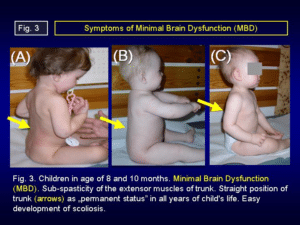
Figure 3: Children between the age of 8 and 10 months. Minimal Brain Dysfunction (MBD). Sub-spasticity of the extensor muscles of the trunk. Straight position of the trunk (arrows) as „permanent status” in all years of the child’s life. Easy development of scoliosis.
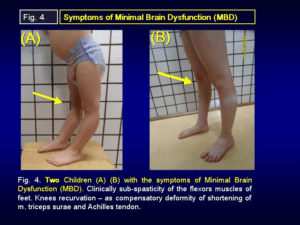
Figure 4: Two Children (A) (B) with the symptoms of Minimal Brain Dysfunction (MBD). Clinically sub-spasticity of the flexors muscles of feet. Knees in recurvation which is a compensatory deformity of shortening of m. triceps surae and Achilles tendon.
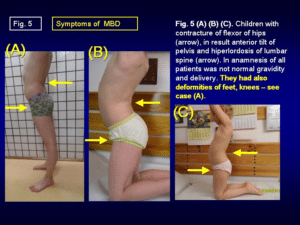
Figure 5: (A) (B) (C): Children with contracture of the flexor of hips (arrow), as a result of anterior tilt of the pelvis and hyperlordosis of the lumbar spine (arrow). In the anamnesis of all patients, there was no normal gravidity and delivery. They had also deformities of feet and knees – see case (A).
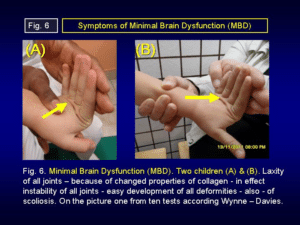
Figure 6: Minimal Brain Dysfunction (MBD). Two children (A) and (B). Laxity of all joints – because of the changed properties of collagen which in effect leads to instability of all joints, easier development of all deformities culminating to scoliosis. In picture one from ten tests according to Wynne – Davies.
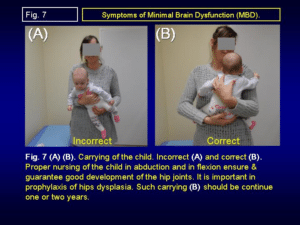
Figure 7: (A) (B). Carrying of the child. Incorrect (A) and correct (B). Proper nursing of the child in abduction and flexion ensures and guarantees good development of the hip joints. It is important in the prophylaxis of hip dysplasia. Such carrying (B) should be continued for one or two years.
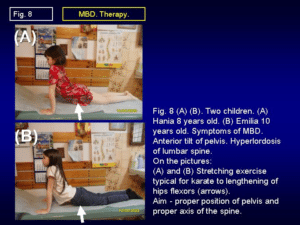
Figure 8: (A) (B). Two children. (A) Hania is 8 years old. (B) Emilia is 10 years old. Symptoms of MBD. The anterior tilt of the pelvis. Hyperlordosis of the lumbar spine. On the pictures: (A) And (B) Stretching exercises typical for karate to lengthen the hips flexors (arrows). The aim is to properly position the pelvis for the proper axis of the spine.
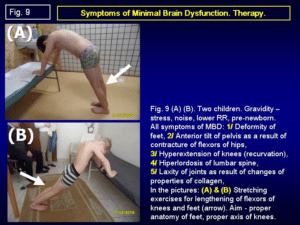
Figure 9: (A) (B): Two children. Gravidity – stress, noise, lower RR, pre-newborn. All symptoms of MBD: 1. Deformity of feet, 2; Anterior tilt of the pelvis as a result of contracture of flexors of hips, 3. Hyperextension of knees (recurvation), 4. Hyperlordosis of the lumbar spine, 5. Laxity of joints as a result of changes in properties of collagen. In pictures: (A) and (B) Stretching exercises for lengthening of flexors of knees and feet (arrow). Aim – proper anatomy of feet and proper axis of knees.
Psychological Therapy
In the therapy of children with MBD, it is very important to give positive influence to the child, to give them love and “positive encouragement” all the time to prevent stress. Give the child all the time love and care. Organizing quality time with the parents or siblings is essential. Music therapy is also crucial. Occupational therapy is very positive in the whole program of treatment as well. The complete psychological and physiotherapy program should be put in place not only at home but also in kindergartens and schools.
Discussion
Among various disorders of the locomotor system in children, and also in youth patients, there are changes connected with the functioning of the Central Nervous System. Such patients account for approximately 18% of all patients in our Out-Patients Clinic. In the diagnosis, it is important to inquire about the gravidity and the delivery. Next, start early physiotherapy by stretching exercises, and from a psychological point of view, it is important to give the child “understanding” and “love”. This group of patients is very sensible and also with “good hearts”. In the case of stretching exercises for older children, sports in the form of karate, taekwondo, and aikido should be introduced to give better results.
Conclusion
- MBD appears in children because of the mother’s problems during pregnancy and/or delivery, sometimes because of illness of CNS with the child
- Clinically in MBD there is shortening of muscles, and tendons, which are called “contractures” because of spasticity or sub-spasticity of the muscles, and at the same time, there is “laxity of joints, capsules, and tendons” as a result of changes in the properties of collagen
- The children with MBD have also psychological changes in their behavior. The only proper therapy is the love and attention given to the child by their parents, and the whole family
- Treatment from childhood should be introduced very early, that is by stretching exercises and positive psychological influence from parents to the child
- Early therapy is the best prophylaxis of pain syndromes and arthrosis of the feet, knees, hips, and spine in adults
Acknowledgment
Many thanks to MA Honorata Menet from the University in Caen, France for correcting the English text.
Conflict of Interest
The authors have no conflict of interest to declare.
References
- Chang HW, Lin CJ, Kuo LC, Tsai MJ, Chieh HF, Su FC. Three-dimensional measurement of foot arch in preschool children. Biomed Eng Online. 2012;11(1):76
- Czochańska J. Badanie i ocena neurorozwojowa niemowląt i noworodków. Wydawnictwo Folium. 1995.
- De Pellegrin M. Subtalar screw – arthrodesis for correction of flat foot in children. Orthopade. 2005;34(9):941-53.
- Karski T. Wpływ osi kończyn na kształt i czynność stóp oraz sposób zużywania obuwia. Przegląd Skórzany. 1986;3(472):53-5.
- Karski T. Wrodzone i nabyte wady stóp u dzieci; Ortopedia, traumatologia i rehabilitacja narządów ruchu, pod redakcją Prof. St. Piątkowskiego, PZWL, Warszawa. 1990:217-20.
- Karski T, Konera W, Malicki M. Statische und jatrogene Knieckplattfussdeformitäten bei Kinder. Erklärung der Erscheinungen und Möglichkeiten der Therapie. Szekesfehervar. 1990;4-6.
- Karski T, Karski J, Snela S, Ostrowski J. Knickfussdeformitäten bei Kindern mit spastischer Verkürzung der Achillessehne. Internationaler Gemeinschaftskongress. 1995;15-17.
- Kałakucki Jarosław. Wybrane parametry rozwoju psycho – ruchowego u dzieci z chorobą Perthesa. (Some parameters of psychological behavior and movement apparatus changes in children with Perthes disease). Praca doktorska / Doctor dissertation. Rok 2010, stron 125. Oprawiony maszynopis. Uniwersytet Medyczny w Lublinie. 2010.
- Kandzierski G, Karski T. ”Radiological changes and MRI of “healthy” femoral head in unilateral Legg-Perthes’ disease”, EPOS 2000, XIX Meeting of the European Pediatric Orthopaedic Society, Congress Book, Milan. 2000;3.
- Tomasz K. Biomechanical Etiology of the So-called Idiopathic Scoliosis (1995 – 2007) – Connection with „Syndrome of Contractures” – Fundamental Information for Pediatricians in Program of Early Prophylactics. Surgical Science. 2014;5:33-8.
- Karski Tomasz, Jacek Karski. Biomechanical etiology of the so-called Idiopathic Scoliosis (1995 – 2007). The causative role of “gait” and “permanent standing ‘at ease’ on the right leg”. New classification. Principles of the new therapy and causal prophylaxis. Canadian Open Medical Science and Medicine J. 2015;16.
- Karski Tomasz, Karski Jacek. Syndrome of contractures and deformities according to prof. Hans Mau as the primary cause of hip, neck, shank, and spine deformities in babies, youth, and adults. American Research J Medicine and Surgery. 2015;1(2).
- Karski Jacek, Tomasz Karski, Jarosław Pyrc, Małgorzata Kulka. Deformations of the feet, knees, hips, and pelvis in children and adults with minimal brain dysfunction. Causes Treatment Prophylaxis Locomotor System. 2016;23(2):20-31.
- Karski Jacek, Karski Tomasz. Imperfect hips as a problem at an older age. early and late prophylactic management before arthrosis. Jacobs Journal of Physiotherapy and Exercises / USA / Texas. 2016;1(2):15.
- Karski Jacek, Tomasz Karski. Pathological changes in locomotors system in children with Minimal Brain Dysfunction (MBD). Causes. Symptoms. Physiotherapy, Arch Physiotherapy Glob Res. 2017;21(2):35-43.
- Karski Tomasz, Jacek Karski. Karate, Taekwondo, Aikido, Kung Fu. Yoga, and other far eastern forms of activities – are not only sports but also the best method of treatment. J Yoga, Physical Therapy and Rehabilitation. 2017;4:8.
- Karski T, Kalakucki J, Karski J. Syndrome of contractures (according to Mau) with the abduction contracture of the right hip as a causative factor for the development of the so-called idiopathic scoliosis. IRSSD, Stud Health Technol Inform. 2006;123:34-9.
- Karski J, Karski T, Kałakucki J, Długosz M. Cerebral palsy – problems of diagnosis and treatment. Lublin RAO method in treatment. Pohyb Ustr. 2010;(17):374-7.
- Karski J, Karski T, Kałakucki J. Contracture of tracts ilio-tibialis as an important factor in etiology of “genu valga idiopathica”, habitual dislocation of the patella. New operative therapy as advising procedure for “Decade of Bone and Joint 2000-2010”. W: 60th Annual International Congress of the Egyptian Orthopaedic Association. Cairo. 2008.
- Karski Tomasz. Rules of Prophylaxis for Hips and Spine – Children and Adults – in Points and Figures, Educative Article, Canada, CPQ Orthopaedics. 2020;5:1.
- Karski Tomasz. Minimal brain dysfunction. children and adults. clinical and psychological symptoms. examples of pathology: rules of therapy. Int J Ortho Res. 2021;4(3):127.
- Karski Tomasz, Karski Jacek, Dudin Mikhail, Pyrc Jaroslaw. Perthes disease etiology symptoms physiotherapy. Int J Ortho Res. 2021:7.
- Łuba R. Działalność badawczo wdrożeniowa Instytutu Przemysłu Skórzanego w zakresie ochrony stóp ludności Polski”- wydrukowana w Przeglądzie Skórzanym. 1994.
- Mau H. Zur Ätiopathogenese von Skoliose, Hüftdysplasie und Schiefhals im Säuglinsalter. Zeitschrift f Orthop. 1979;5:601-5.
- Mau H. Die Atiopatogenese der Skoliose, Bücherei des Orthopäden, 23 Band, Enke Verlag Stuttgart. 1982;1-110.
- Oleszczuk J, Szymański W, Wilczyński. “Patologia ciąży” in ‘Położnictwo” Klimek Rudolf, Dream Publ Comp Inc Kraków. 1999:395-499.
- Oleszczuk J, Chazan B, Kamiński K, Leszczyńska-Gorzelak B, Skręt A, Szymański W. “Poród patologiczny” in ‘Położnictwo” Klimek Rudolf, Dream Publ. Comp.Inc., Kraków, 1999:291-337.
- Tarczyńska M, Karski T, Frelek-Karska M. Prenatal conditions for the development of the hip dysplasia in the material of 223 pregnant women, the followed-up study of the newborn children”. EPOS 2000, XIX Meeting of the European Pediatric Orthopaedic Society, Congress Book. 2000:8.
- www.ortopedia.karski.lublin.pl [Last accessed on: June 20, 2023]
Article Type
Research Article
Publication History
Received Date: 06-06-2023
Accepted Date: 20-06-2023
Published Date: 27-06-2023
Copyright© 2023 by Karski T, et al. All rights reserved. This is an open access article distributed under the terms of the Creative Commons Attribution License, which permits unrestricted use, distribution, and reproduction in any medium, provided the original author and source are credited.
Citation: Karski T, et al. Minimal Brain Dysfunctions (MBD): Causes, Clinical Symptoms – Deformity of The Feet, Knees, Hips, Pelvis and Spine. Physiotherapy. J Ortho Sci Res. 2023;4(2):1-9.

Figure 1: Child with the symptoms of Minimal Brain Dysfunction (MBD). Sub-spasticity of the flexors of the feet and as a result their shortening. Through functions like walking early and sometimes as a result of incorrect therapy we notice a deformity like pedes Plano-valgus (arrows).

Figure 2: Child 3-month-old (A and B). The symptoms of Minimal Brain Dysfunction (MBD) and Syndrome of Contracture and Deformities (SofCD). Limited abduction of the hips (B) – the danger of dysplasia. Clinically shortening of adductors of both hips (arrows). Such children need permanent nursing with the abduction of the hips for 1 or 2 years. The wry neck on the left side – needs rotation stretching to the left side.

Figure 3: Children between the age of 8 and 10 months. Minimal Brain Dysfunction (MBD). Sub-spasticity of the extensor muscles of the trunk. Straight position of the trunk (arrows) as „permanent status” in all years of the child’s life. Easy development of scoliosis.

Figure 4: Two Children (A) (B) with the symptoms of Minimal Brain Dysfunction (MBD). Clinically sub-spasticity of the flexors muscles of feet. Knees in recurvation which is a compensatory deformity of shortening of m. triceps surae and Achilles tendon.

Figure 5: (A) (B) (C): Children with contracture of the flexor of hips (arrow), as a result of anterior tilt of the pelvis and hyperlordosis of the lumbar spine (arrow). In the anamnesis of all patients, there was no normal gravidity and delivery. They had also deformities of feet and knees – see case (A).

Figure 6: Minimal Brain Dysfunction (MBD). Two children (A) and (B). Laxity of all joints – because of the changed properties of collagen which in effect leads to instability of all joints, easier development of all deformities culminating to scoliosis. In picture one from ten tests according to Wynne – Davies.

Figure 7: (A) (B). Carrying of the child. Incorrect (A) and correct (B). Proper nursing of the child in abduction and flexion ensures and guarantees good development of the hip joints. It is important in the prophylaxis of hip dysplasia. Such carrying (B) should be continued for one or two years.

Figure 8: (A) (B). Two children. (A) Hania is 8 years old. (B) Emilia is 10 years old. Symptoms of MBD. The anterior tilt of the pelvis. Hyperlordosis of the lumbar spine. On the pictures: (A) And (B) Stretching exercises typical for karate to lengthen the hips flexors (arrows). The aim is to properly position the pelvis for the proper axis of the spine.

Figure 9: (A) (B): Two children. Gravidity – stress, noise, lower RR, pre-newborn. All symptoms of MBD: 1. Deformity of feet, 2; Anterior tilt of the pelvis as a result of contracture of flexors of hips, 3. Hyperextension of knees (recurvation), 4. Hyperlordosis of the lumbar spine, 5. Laxity of joints as a result of changes in properties of collagen. In pictures: (A) and (B) Stretching exercises for lengthening of flexors of knees and feet (arrow). Aim – proper anatomy of feet and proper axis of knees.


